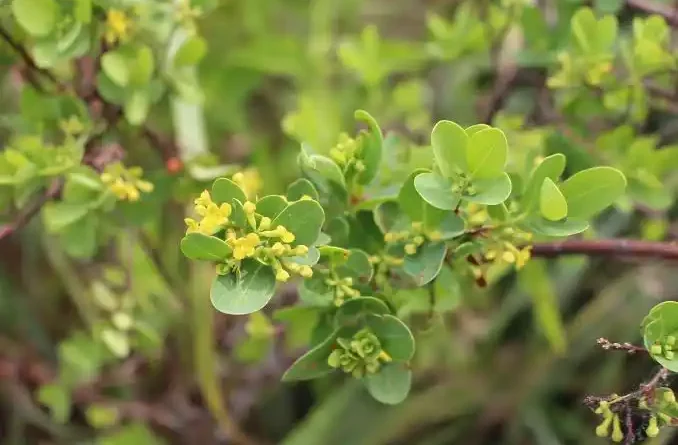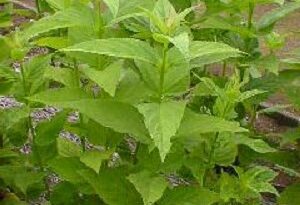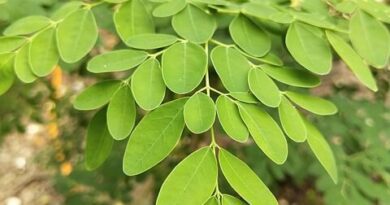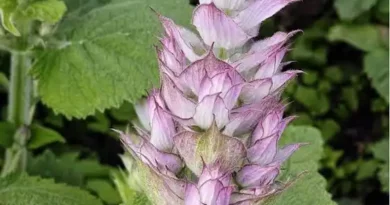9 Medicinal Health Benefits Of Wikstroemia indica (Sweet Indrajao)
Wikstroemia indica, commonly known as Sweet Indrajao or Sweet Kurial, is a flowering shrub native to various regions across Asia, including India, China, and Southeast Asia. This plant belongs to the Thymelaeaceae family and is recognized for its ornamental value as well as its historical and medicinal significance in traditional practices.
The Sweet Indrajao shrub typically grows to a height of about 1 to 2 meters, boasting slender branches adorned with lance-shaped leaves. The leaves, which are glossy green and arranged alternately along the stems, contribute to the plant’s overall visual appeal.
One of the most striking features of Wikstroemia indica is its flowers. The plant produces small, tubular, fragrant flowers that bloom in clusters. These flowers come in various colors, including white, yellow, pink, or purple, depending on the specific cultivar or regional variation. Their delicate appearance and sweet fragrance make them attractive to pollinators like bees and butterflies.
Beyond its aesthetic value, Sweet Indrajao has a rich history of traditional medicinal uses. Various parts of the plant, including the roots, stems, and leaves, have been employed in indigenous medicine systems for their potential therapeutic properties. In traditional practices, extracts or decoctions from Sweet Indrajao were used to treat ailments such as skin conditions, fevers, and digestive issues. Additionally, the plant has been studied for its potential pharmacological properties and compounds that may exhibit antibacterial and anti-inflammatory effects.
Culturally, Wikstroemia indica holds significance in some religious and spiritual contexts in parts of Asia. In certain traditions, the plant has been associated with rituals, ceremonies, or symbolic representations, adding to its cultural importance.
However, it’s important to note that while Sweet Indrajao has a history of traditional uses, any medicinal application should be approached with caution and ideally under the guidance of a qualified healthcare professional due to potential variations in potency and safety.
In landscaping, Sweet Indrajao is appreciated for its ornamental value, often cultivated in gardens or parks for its attractive flowers and foliage. Its relatively low maintenance requirements and adaptability to various soil types make it a favored choice for ornamental purposes in suitable climates.
Overall, Wikstroemia indica, or Sweet Indrajao, stands out as an aesthetically pleasing shrub with historical significance in traditional medicine and cultural practices, showcasing the diverse roles plants play in human societies beyond their visual appeal.
The Botanical Description of Wikstroemia indica
1. Morphology: Wikstroemia indica, commonly known as “Sweet Indrajao” or “Sandal ka Phool,” is a deciduous shrub belonging to the Thymelaeaceae family. It typically grows to a height of 2-3 meters, displaying a bushy and branching structure. The leaves are simple, opposite, and elliptical in shape, with a smooth texture and a glossy green color.
2. Flowers: The plant produces small, fragrant flowers that are arranged in dense clusters. These flowers have a tubular shape and feature a distinct, pleasant fragrance. The color of the flowers can vary, ranging from white to light pink, adding to the ornamental appeal of the shrub.
3. Fruits: Wikstroemia indica bears small, spherical fruits that develop after the flowering period. These fruits are typically green when young and may turn brown as they mature. While the fruits are not a primary focus for cultivation, they contribute to the overall aesthetic of the plant.
4. Bark and Stem: The bark of Wikstroemia indica is smooth and greyish-brown in color. The stems are slender, often with a slightly zigzag pattern. The overall appearance of the plant reflects its adaptability to different environments and its ability to thrive in diverse climates.
5. Habitat: This species is native to various regions, including parts of Asia and Africa. It demonstrates versatility in adapting to different soil types and climate conditions, making it suitable for cultivation in a range of geographical locations.
The Geographic Distribution of Wikstroemia indica
1. Native Regions: Wikstroemia indica is native to several regions, with a distribution that spans parts of Asia and Africa. It is found in countries such as India, China, Nepal, Myanmar, Sri Lanka, and various African nations. The plant’s adaptability has led to its presence in a variety of ecosystems within these regions.
2. Climate Preferences: This shrub thrives in subtropical and tropical climates, where temperatures are generally warm. It can withstand a range of environmental conditions, including both humid and arid climates, showcasing its resilience and adaptability.
3. Altitudinal Range: Wikstroemia indica is often found at varying altitudes, from lowland areas to higher elevations. The plant’s ability to grow across different altitudinal ranges contributes to its widespread distribution and availability in diverse landscapes.
4. Cultivation Beyond Native Regions: Due to its ornamental value and traditional uses, Wikstroemia indica has been introduced to other parts of the world through cultivation. In some regions, it is grown in gardens and landscapes for its aesthetic appeal and the fragrance of its flowers.
The Chemical Composition of Wikstroemia indica
1. Alkaloids: Wikstroemia indica contains alkaloids, nitrogen-containing compounds with potential pharmacological effects. These compounds contribute to the plant’s medicinal properties and may have applications in traditional medicine.
2. Flavonoids: Flavonoids, known for their antioxidant properties, are present in Wikstroemia indica. These compounds play a role in protecting the plant from oxidative stress and may offer health benefits to those who consume or use the plant in various forms.
3. Essential Oils: The plant produces essential oils, contributing to the aromatic nature of Wikstroemia indica. These oils may have therapeutic effects and are often utilized in traditional practices such as aromatherapy.
4. Tannins: Tannins, with astringent properties, are found in Wikstroemia indica. These may contribute to the plant’s traditional uses, including applications in skincare and wound healing.
5. Terpenoids: Wikstroemia indica contains terpenoids, a diverse group of compounds with potential biological activities. These compounds may contribute to the plant’s overall pharmacological profile and could be of interest in further research.
6. Coumarins: Coumarins, aromatic compounds with potential health benefits, are also present in Wikstroemia indica. These compounds may have anticoagulant and anti-inflammatory properties, among other potential effects.
7. Glycosides: Certain glycosides are identified in Wikstroemia indica. These compounds may have bioactive properties and contribute to the overall chemical complexity of the plant.
8. Phenolic Compounds: Phenolic compounds, known for their antioxidant properties, are part of the chemical composition of Wikstroemia indica. These compounds may contribute to the plant’s ability to combat oxidative stress.
Read Also: 5 Medicinal Health Benefits Of Vaccinium myrtillus (Bilberry)
The Medicinal Health Benefits Of Wikstroemia indica (Sweet Indrajao)

1. Anti-Inflammatory Properties: Wikstroemia indica has demonstrated anti-inflammatory effects, making it valuable in traditional medicine for alleviating conditions associated with inflammation. Compounds present in the plant may help reduce inflammation and provide relief from related symptoms.
2. Analgesic Effects: The plant is known for its analgesic properties, offering pain-relieving effects. This makes it beneficial for managing various types of pain, including mild to moderate pain associated with conditions such as headaches or muscle discomfort.
3. Antipyretic Action: Wikstroemia indica is traditionally used as an antipyretic agent, helping to reduce fever. The plant’s properties may contribute to normalizing body temperature during fever episodes.
4. Wound Healing: The medicinal plant is believed to have wound-healing properties. Topical application or the use of derived products may aid in the healing process of cuts, bruises, and other skin injuries.
5. Antioxidant Benefits: With its rich chemical composition, Wikstroemia indica exhibits antioxidant effects. Antioxidants help combat oxidative stress in the body, potentially reducing the risk of chronic diseases and supporting overall health.
6. Respiratory Health Support: Traditional uses include the plant’s role in supporting respiratory health. It may be utilized to alleviate symptoms of respiratory conditions, providing relief from coughs or congestion.
7. Gastrointestinal Relief: Wikstroemia indica is employed in traditional medicine for gastrointestinal issues. It may have a soothing effect on the digestive system, aiding in the relief of digestive discomfort and promoting overall digestive well-being.
8. Anti-microbial Properties: The plant is thought to possess anti-microbial properties, which could contribute to its traditional use in addressing microbial infections. Further research is needed to explore the specific mechanisms and applications.
9. Immune System Support: Some traditional practices involve the use of Wikstroemia indica to support the immune system. Its potential immune-modulating properties may assist in maintaining a healthy immune response.
The Methods of Usage to Achieve the Provided Health Benefits Of Wikstroemia indica (Sweet Indrajao)
1. Infusions and Teas: One common method of consumption is through infusions or teas made from the leaves or other parts of Wikstroemia indica. This allows for the extraction of beneficial compounds for internal use.
2. Topical Applications: For wound healing and skin-related benefits, topical applications using extracts or ointments derived from Wikstroemia indica are employed. This method targets specific areas for localized effects.
3. Decoctions: The preparation of decoctions involves boiling plant parts to extract medicinal properties. This method is often used for internal consumption to address issues such as fever or respiratory conditions.
4. Poultices: Poultices, made by crushing or grinding plant parts, are applied directly to the skin for localized relief. This method is commonly used for addressing bruises, cuts, or inflammatory conditions.
5. Tinctures: Tinctures involve extracting medicinal compounds using alcohol or other solvents. These concentrated extracts can be consumed in small doses, providing a potent form of the plant’s benefits.
6. Capsules or Tablets: In modern herbal medicine, Wikstroemia indica may be formulated into capsules or tablets for convenient consumption. This allows individuals to benefit from its medicinal properties in a controlled and measured manner.
7. Inhalation: Steam inhalation with extracts from Wikstroemia indica may be used to address respiratory issues. Inhaling the vapor allows the beneficial compounds to reach the respiratory system directly.
The Side Effects Of Using Wikstroemia indica Medicinal Plant
1. Allergic Reactions: Individuals with allergies to plants in the Thymelaeaceae family should exercise caution, as allergic reactions may occur. Symptoms may include skin irritation, itching, or respiratory issues.
2. Gastrointestinal Distress: In some cases, the consumption of Wikstroemia indica may lead to gastrointestinal discomfort, including nausea or stomach upset. It is advisable to start with small amounts to assess individual tolerance.
3. Skin Sensitivity: Topical applications may cause skin sensitivity in certain individuals. It is recommended to perform a patch test before widespread use to avoid adverse skin reactions.
4. Interaction with Medications: Individuals taking medications should consult with a healthcare professional before using Wikstroemia indica, as it may interact with certain medications and affect their efficacy.
5. Pregnancy and Lactation: Pregnant and lactating individuals should exercise caution, and it is advisable to seek medical guidance before using Wikstroemia indica, as its safety during these periods is not well-established.
6. Avoiding Excessive Consumption: While Wikstroemia indica has various health benefits, excessive consumption may lead to adverse effects. It is crucial to adhere to recommended dosages and usage guidelines.
7. Not a Substitute for Professional Medical Advice: Wikstroemia indica should complement, not replace, professional medical advice and treatment. Individuals with existing health conditions should consult healthcare providers before incorporating it into their health regimen.
Read Also: How to Care for your Livestock Animals Health
The Scientific Research and Studies of Wikstroemia indica (Sweet Indrajao)

1. Anti-Inflammatory Properties: Numerous scientific studies have explored the anti-inflammatory properties of Wikstroemia indica. Research indicates that the plant contains bioactive compounds with potential anti-inflammatory effects, making it a subject of interest for conditions associated with inflammation.
2. Analgesic Effects: Scientific investigations into the analgesic effects of Wikstroemia indica have shown promising results. Compounds present in the plant may contribute to its pain-relieving properties, as observed in studies focusing on its analgesic potential.
3. Antipyretic Action: Studies have delved into the antipyretic action of Wikstroemia indica, shedding light on its traditional use in reducing fever. Scientific evidence suggests that the plant may indeed possess compounds that contribute to its antipyretic effects.
4. Wound Healing: Scientific research supporting the wound-healing properties of Wikstroemia indica is emerging. Studies have explored the plant’s ability to promote the healing process of wounds, offering insights into its potential applications in dermatology.
5. Antioxidant Benefits: The rich chemical composition of Wikstroemia indica has attracted attention for its antioxidant benefits. Scientific studies have investigated its capacity to neutralize oxidative stress, highlighting its potential role in preventing oxidative damage.
6. Respiratory Health Support: Scientific inquiries have examined Wikstroemia indica’s role in supporting respiratory health. Research suggests that the plant may have respiratory benefits, providing a scientific basis for its traditional use in addressing respiratory conditions.
7. Gastrointestinal Relief: Studies have explored the gastrointestinal effects of Wikstroemia indica, corroborating its traditional use for digestive issues. Scientific evidence supports the plant’s potential to soothe the digestive system and alleviate gastrointestinal discomfort.
8. Anti-microbial Properties: Scientific investigations have aimed to understand Wikstroemia indica’s anti-microbial properties. While research is ongoing, preliminary findings suggest that the plant may exhibit activity against certain microbes.
9. Immune System Support: Scientific studies have explored the immune-modulating properties of Wikstroemia indica. Research indicates that the plant may contribute to supporting a healthy immune response, although further studies are needed to elucidate the mechanisms involved.
The Safety Precautions and Recommendations In Using Wikstroemia indica (Sweet Indrajao) Medicinal Plant
1. Allergies and Sensitivities: Individuals with known allergies to plants in the Thymelaeaceae family, to which Wikstroemia indica belongs, should exercise caution. Allergic reactions such as skin irritation or respiratory issues may occur.
2. Dosage and Consumption: It is advisable to adhere to recommended dosages when using Wikstroemia indica. Excessive consumption may lead to adverse effects, and individuals should start with small amounts to assess individual tolerance.
3. Topical Application: When applying Wikstroemia indica topically, especially in the form of extracts or ointments, a patch test is recommended to check for skin sensitivity. Discontinue use if any adverse reactions occur.
4. Interaction with Medications: Individuals taking medications should consult with healthcare professionals before using Wikstroemia indica, as it may interact with certain medications. This is crucial to prevent potential interactions and ensure the safety of concurrent use.
5. Pregnancy and Lactation: Pregnant and lactating individuals should exercise caution and seek medical advice before using Wikstroemia indica. Limited information is available regarding its safety during these periods.
6. Not a Substitute for Professional Medical Advice: Wikstroemia indica should complement, not replace, professional medical advice and treatment. Individuals with existing health conditions should consult healthcare providers before incorporating it into their health regimen.
FAQs About Wikstroemia indica (Sweet Indrajao) Medicinal Plant
1. Is Wikstroemia indica safe for long-term use?
While Wikstroemia indica is generally considered safe for short-term use, long-term use may require monitoring and supervision. It is advisable to consult with a healthcare professional for personalized guidance based on individual health conditions.
2. Can Wikstroemia indica be used by children?
The use of Wikstroemia indica in children should be approached with caution. Consultation with a pediatrician is recommended before administering it to children, considering their age, weight, and specific health needs.
3. Are there any known drug interactions with Wikstroemia indica?
Wikstroemia indica may interact with certain medications. It is crucial to inform healthcare providers about any ongoing medication regimens to assess potential interactions and ensure the safety of use.
4. How should Wikstroemia indica be stored?
Store Wikstroemia indica products in a cool, dry place away from direct sunlight. Follow the specific storage instructions provided with the product or as advised by healthcare professionals.
5. Can Wikstroemia indica be used during pregnancy?
Pregnant individuals should consult with healthcare providers before using Wikstroemia indica, as its safety during pregnancy is not well-established. Individual health conditions and potential risks should be considered.
6. Does Wikstroemia indica have any known contraindications?
Individuals with known allergies to plants in the Thymelaeaceae family should avoid Wikstroemia indica. Additionally, those with specific medical conditions or sensitivities should seek professional medical advice before use.
Read Also: What You Don’t Know About Mushroom Farming









